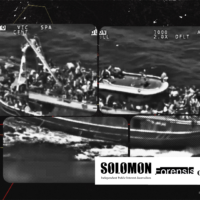Migration
Journalism
Award
The Pylos Shipwreck
In the early hours of June 14, the state-of-the-art cameras of the Coast Guard vessel ΠΠΛΣ-920 were off.
The deadliest shipwreck within the Greek Search and Rescue Zone, one of the largest the Mediterranean has ever seen, was reportedly not visually detected.
Only hours before, aerial photos of the overloaded fishing vessel were taken. Nearby tankers recorded videos before they were ordered to leave the scene. There were satellite images that captured its movement.
But the exact circumstances in which the Adriana capsized off Pylos, killing more than 600 people, remain unclear three weeks on.
In affidavits and interviews, some of the 104 survivors attributed the sinking of the fishing vessel to an attempt by the Hellenic Coast Guard to tow it to Italian waters.
The Coast Guard emphasizes that it saved human lives, and maintains that the fishing vessel overturned due to a disturbance by the passengers.
Solomon, in a joint investigation with the research group Forensis, The Guardian and German public broadcaster ARD reveals: the Coast Guard vessel ΠΠΛΣ-920, the only vessel present at the time the Adriana capsized, was obligated to “document its operation by video-recording” in accordance with a 2021 Frontex document which recommends that the Greek authorities record their operations continually.
If this had been done, today there would be answers to the questions that the victims’ families are still asking.
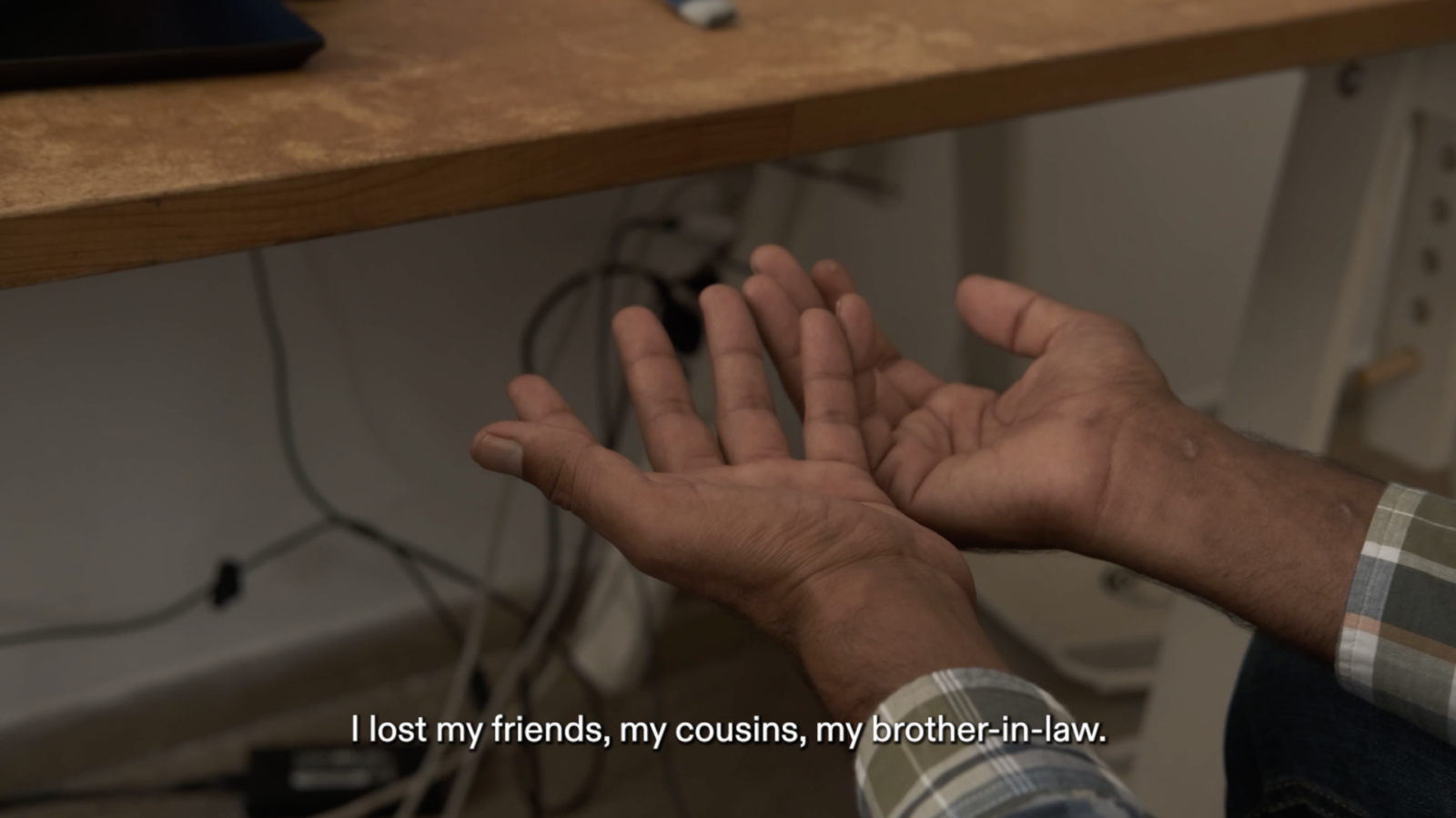
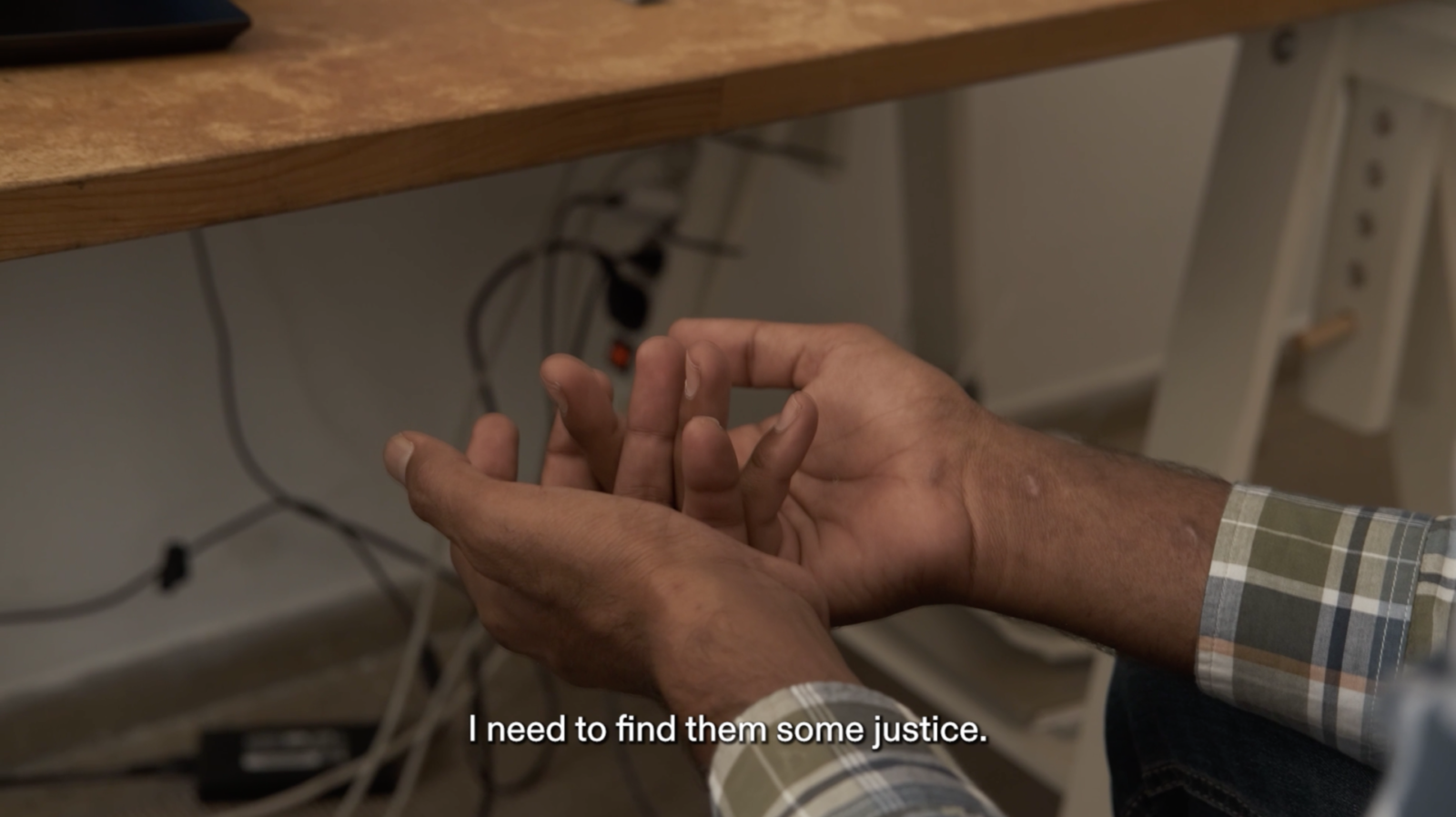
The ΠΠΛΣ-920 cameras were supposed to record
By midday on June 13, the Greek and Italian authorities and Frontex (the European Border and Coast Guard Agency), were aware of the overloaded fishing vessel, which had been sailing aimlessly for four days in the central Mediterranean – its only means of navigation was a compass and the position of the sun.
The activist network Alarm Phone had also relayed to the authorities the desperate SOS of some 750 men, women, and children — mostly from Pakistan, Egypt and Syria — who, lacking potable water, were using their shoelaces to lower containers into the sea: “They are urgently asking for help”.
ΠΠΛΣ-920, the Coast Guard vessel which received the order to depart from the port of Souda, Crete to assist, has been the pride of the Coast Guard since 2021. European funding covered 90% of its cost, and it is one of the best-equipped vessels available in Greece.
And it could not be in better hands: earlier this year, in March, its captain was awarded for “his valuable contribution to the protection of maritime borders and human life at sea.”
According to the Coast Guard, ΠΠΛΣ-920, like its three sister ships (ΠΠΛΣ-900, ΠΠΛΣ-910 and ΠΠΛΣ-930), has two state-of-the-art thermal camera systems. According to the Coast Guard, however, when the fishing vessel capsized, the cameras were not in operation because the crew’s attention was focused on the rescue efforts.
“When we have an incident, we try to have the ability to operate seamlessly. Making some crew members ‘inactive’ so that they can record a video, you understand, is unethical,” Coast Guard spokesman Nikos Alexiou stated on June 15, justifying why the incident was not recorded on video.
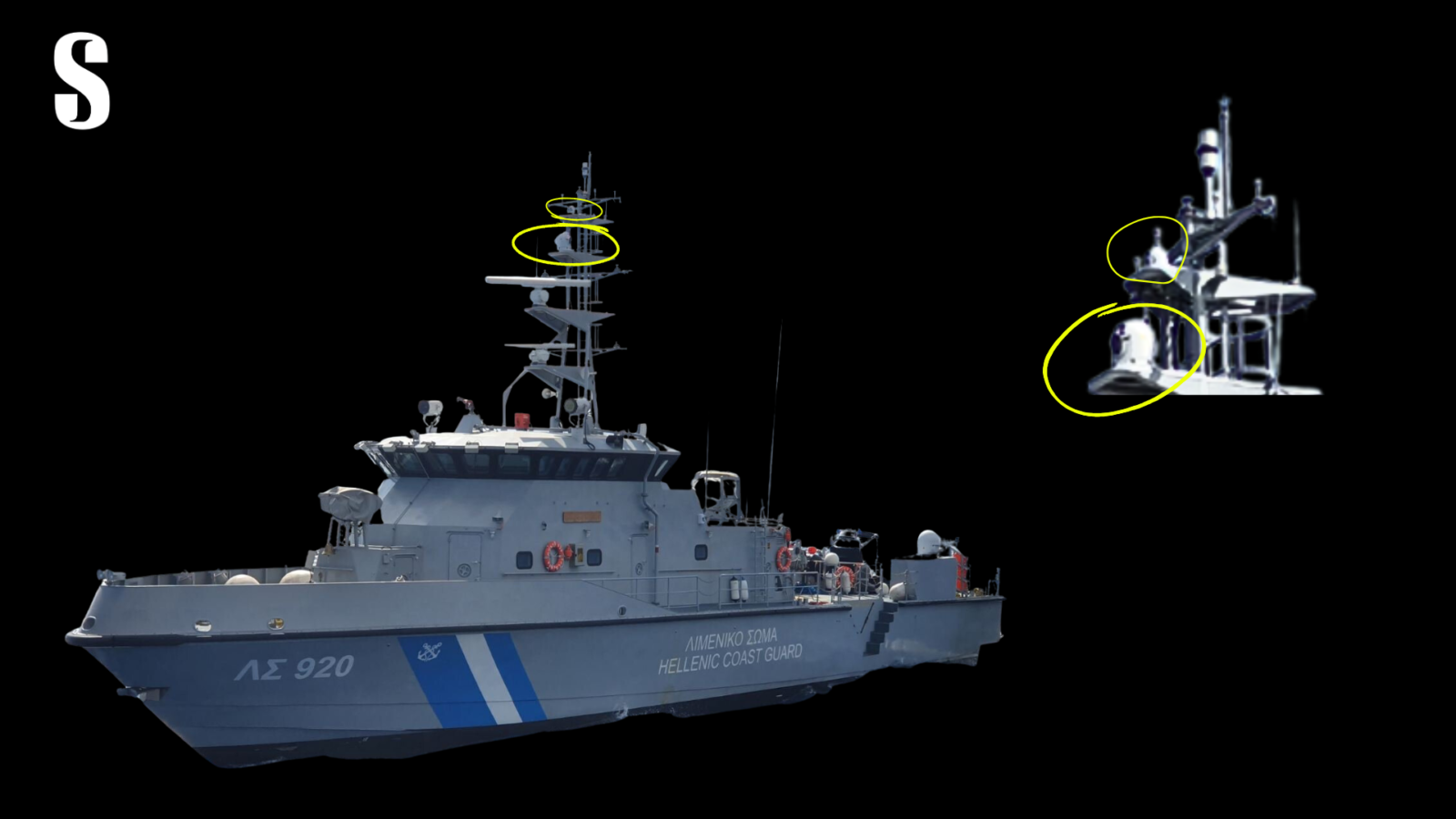
ΠΠΛΣ-920 is equipped with two state-of-the-art thermal cameras.
However, one of the three former and current Coast Guard officers who spoke to us during our investigation, said that these cameras do not require constant manual operation and they exist exactly for this reason – to record such incidents.
But there is still a critical issue: a document reveals that, according to Frontex recommendations in March 2021, the Coast Guard vessel was obligated to record the operation.
The document states that “if feasible, all actions taken by Frontex assets or Frontex co-financed assets… should be documented by video consistently.”
The cost of the ΠΠΛΣ-920, one of four state-of-the-art vessels purchased for €55.5 million, has been 90% financed through Frontex. It is designated to be “available for four months a year, for Frontex missions outside of Greek waters.”
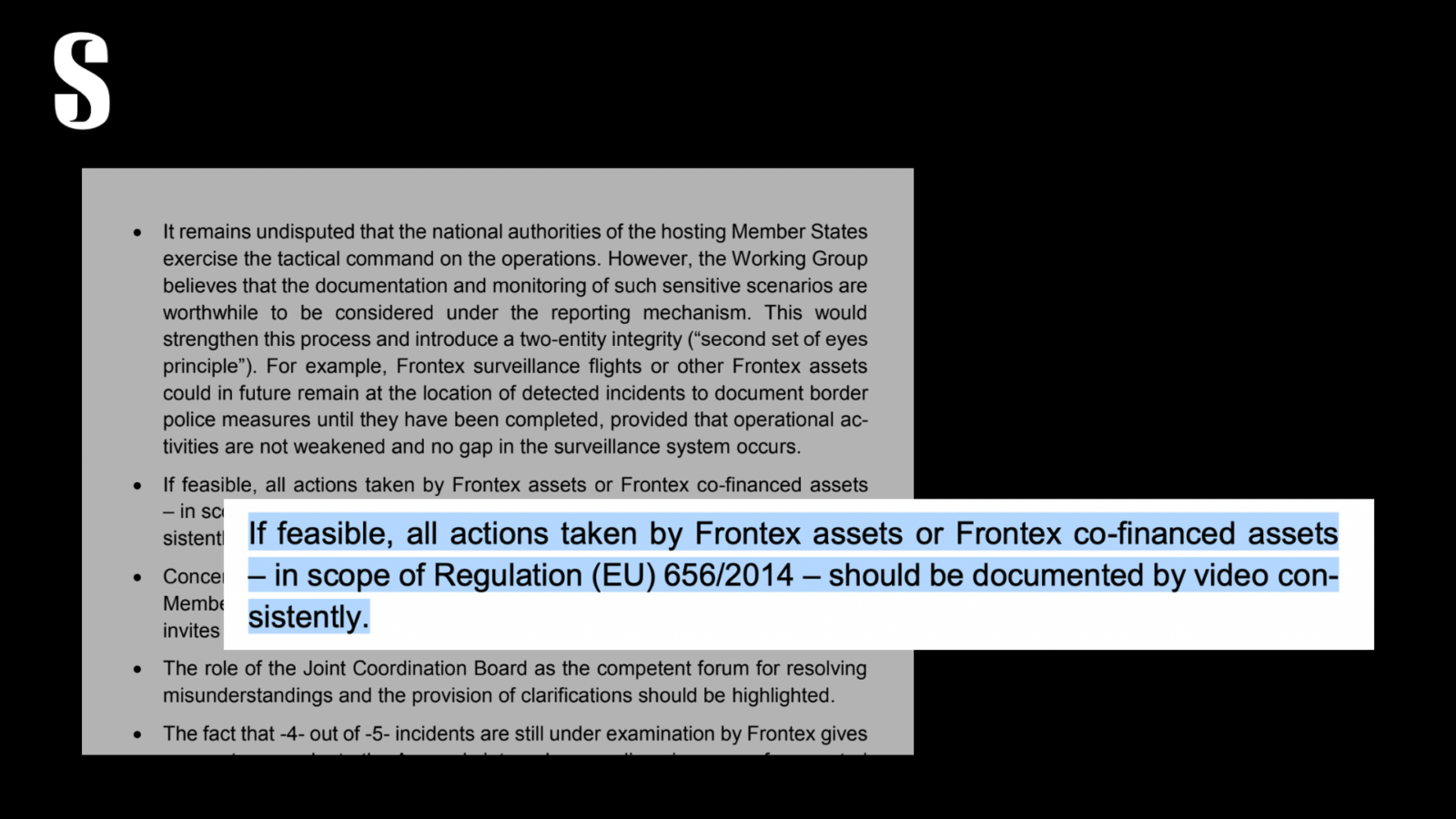
In March 2021, Frontex calls for the Coast Guard vessels funded by the organisation to video record their operations.
Frontex had recommended the visual recording of operations, during a meeting where representatives from Greece were present as well as from other European countries, following complaints of human rights violations by the Coast Guard.
The complaints that were assessed during the meeting referred to the exact same practice, attributed to ΠΠΛΣ-920: towing vessels of asylum seekers outside of Greek waters.
We created a 3D model of the Adriana
Solomon, Forensis, The Guardian and ARD worked together and after analyzing a wealth of evidence, we present the most complete picture to date, of the Adriana’s course up to the time of its sinking.
We collected more than 20 survivor accounts and analyzed material derived from, among others, witness statements, official reports from the Coast Guard and Frontex, deck logs of the Coast Guard vessel and tankers in transit, aerial photographs and data on the position and movement of ships and aircraft. We also secured exclusive footage from the commercial vessels that were in the area and spoke to sources at Frontex, the Coast Guard, and rescuers.
The analysis of this information resulted in a detailed chronology of the events that occurred on June 13 and 14, an interactive map showing Adriana‘s movement, as well as a 3D model of the fishing vessel.
With the help of the 3D model, we were able to do what no official authority or journalistic investigation has done so far: to conduct in-person interviews with survivors of the wreck, using the visual impression of this body of data.
Trawler by Forensis on Sketchfab
Using the method of situated testimony, the survivors placed themselves in the 3D model of the ship, indicated their location on the deck, and recalled the events that unfolded before the sinking of the Adriana: from the alleged towing to its capsize.
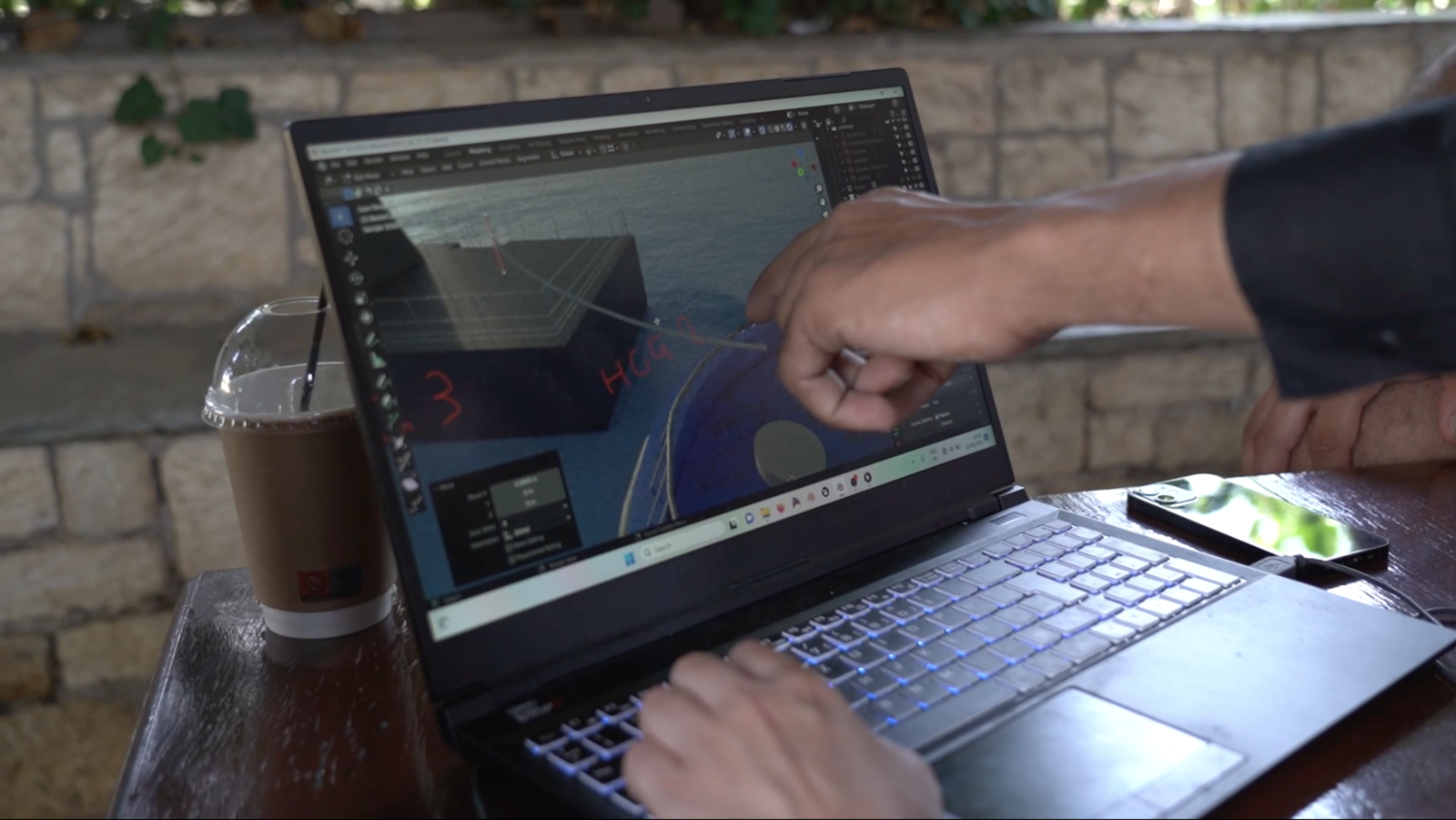
A survivor, using the 3D model, points to the blue rope which was used to tow the Adriana.
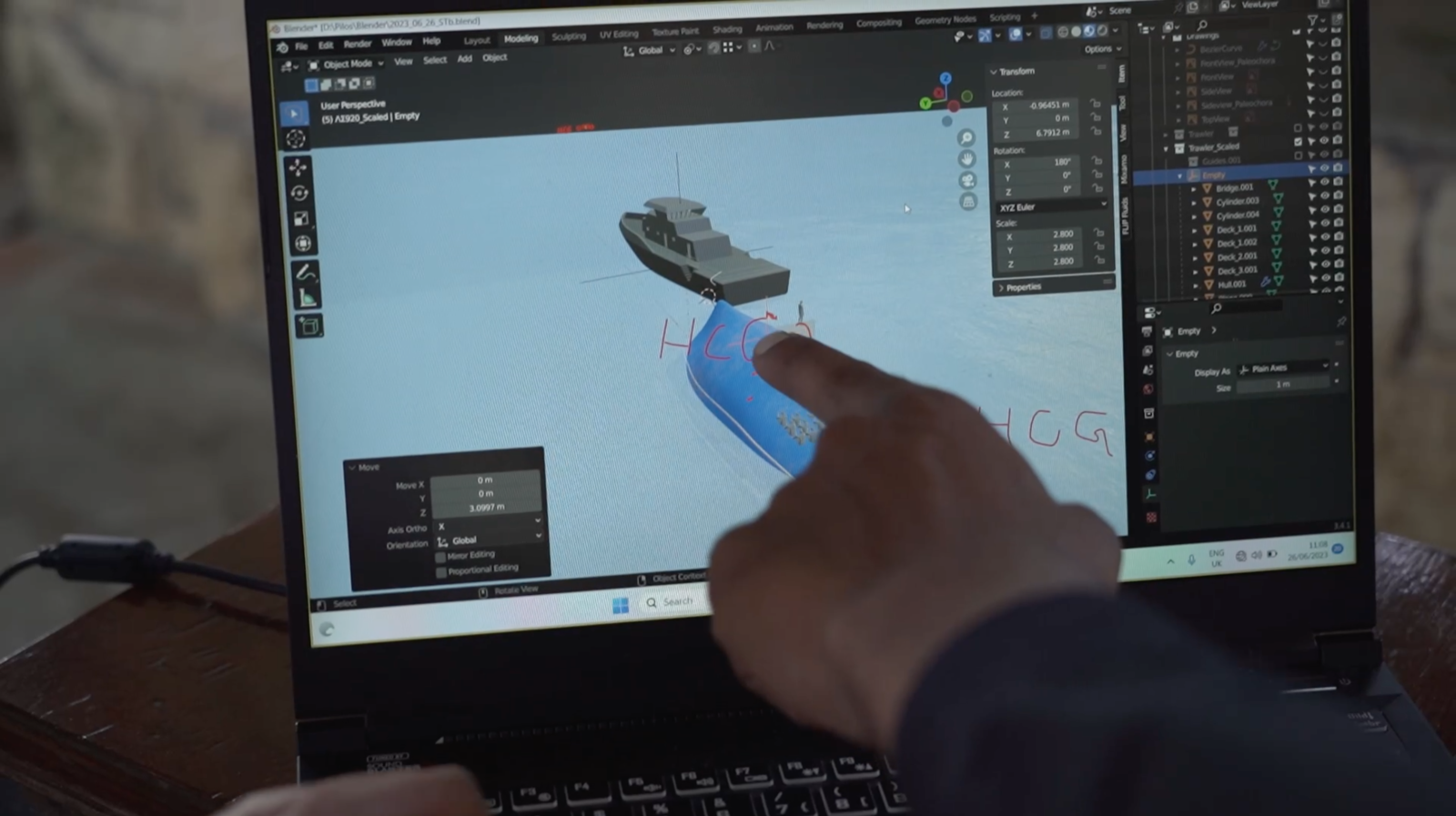
A survivor uses the 3D model to describe how the fishing vessel overturned.
In this way, we were able to cross-reference accounts of what happened in the presence of the Coast Guard vessel, based on each person’s eyewitness account.
Main conclusions
Eleven critical findings emerge from the joint investigation:
- Frontex offered to help three times. A Frontex source stated that the Coast Guard did not respond to any of the three requests for assistance.
- The records of ΠΠΛΣ-920 are incoherent and raise questions. For example, while it is reported that immediately before the sinking, the fishing vessel was moving west, it actually appears to be moving for about an hour (00:44 – 01:40) in a southerly direction at a speed of only 0.6 knots.
- While the fishing vessel’s engine was running but there was no navigation capability, according to testimonies, ΠΠΛΣ-920 approached the vessel and gave directions to Italy. A survivor stated: “[a crew member] told us that the Greek ship would go ahead of us and lead us to Italian waters. He told us that in two hours we would be in Italy.” ΠΠΛΣ-920 directed the fishing vessel from a distance, which followed until its engine broke down again.
- According to Syrian survivors on deck, when the engine broke down, masked men from ΠΠΛΣ-920 boarded the fishing vessel and tied a blue rope to the stern. The above-mentioned testimonies are also consistent with an entry in the ΠΠΛΣ-920 deck logbook, which mentions the participation of a four-member team from the Special Missions Unit in the operation.
- According to the same survivors, there were two brief attempts to tow the fishing vessel. The first time the rope broke. The second time the ΠΠΛΣ-920 increased its speed and the fishing vessel rocked to the right, then to the left, then to the right again and flipped onto its right side.
- The Pakistani survivors were located in the interior of the ship, and could not see what was happening. They stated, however, that while the fishing vessel’s engine was not working, they felt a sharp forward thrust “like a rocket” — a sensation that corroborates the use of a rope for towing.
- Testimonies in this investigation support testaments presented by other journalistic investigations, as well as survivor statements included in the official case file: this action appears to have led to the capsize and eventual sinking of the ship.
- The fishing vessel capsized and survivors climbed on top of it. ΠΠΛΣ-920 left the scene, creating waves that made it more difficult for the survivors to stay afloat.
- After withdrawing, ΠΠΛΣ-920 directed its floodlights on the shipwreck site. Survivors tried to swim to the Coast Guard vessel, but the distance was too great.
- ΠΠΛΣ-920 began the rescue operation 30 minutes after the sinking, and only after the fishing vessel had completely disappeared from the water’s surface.
- Survivors claim that their phones (which were protected in plastic cases) contain visual material from the incident. Immediately after the rescue, according to the same testimonies, Coast Guard officers confiscated their phones, which have not been returned to them.
Survivor accounts of the towing
In the deck log of ΠΠΛΣ-920, which we have seen, there is no mention of any towing attempt. The Coast Guard captain reports that they approached the fishing vessel to offer assistance, received no response, and followed it “from a discreet distance”.
This is disputed by the accounts of the survivors, some of whom not only tell of a rope that was tied to the fishing vessel, but they all mention its color: blue.
This investigation documents, for the first time, the blue cable that was used by ΠΠΛΣ-920, which can also be seen in earlier photos of the vessel.
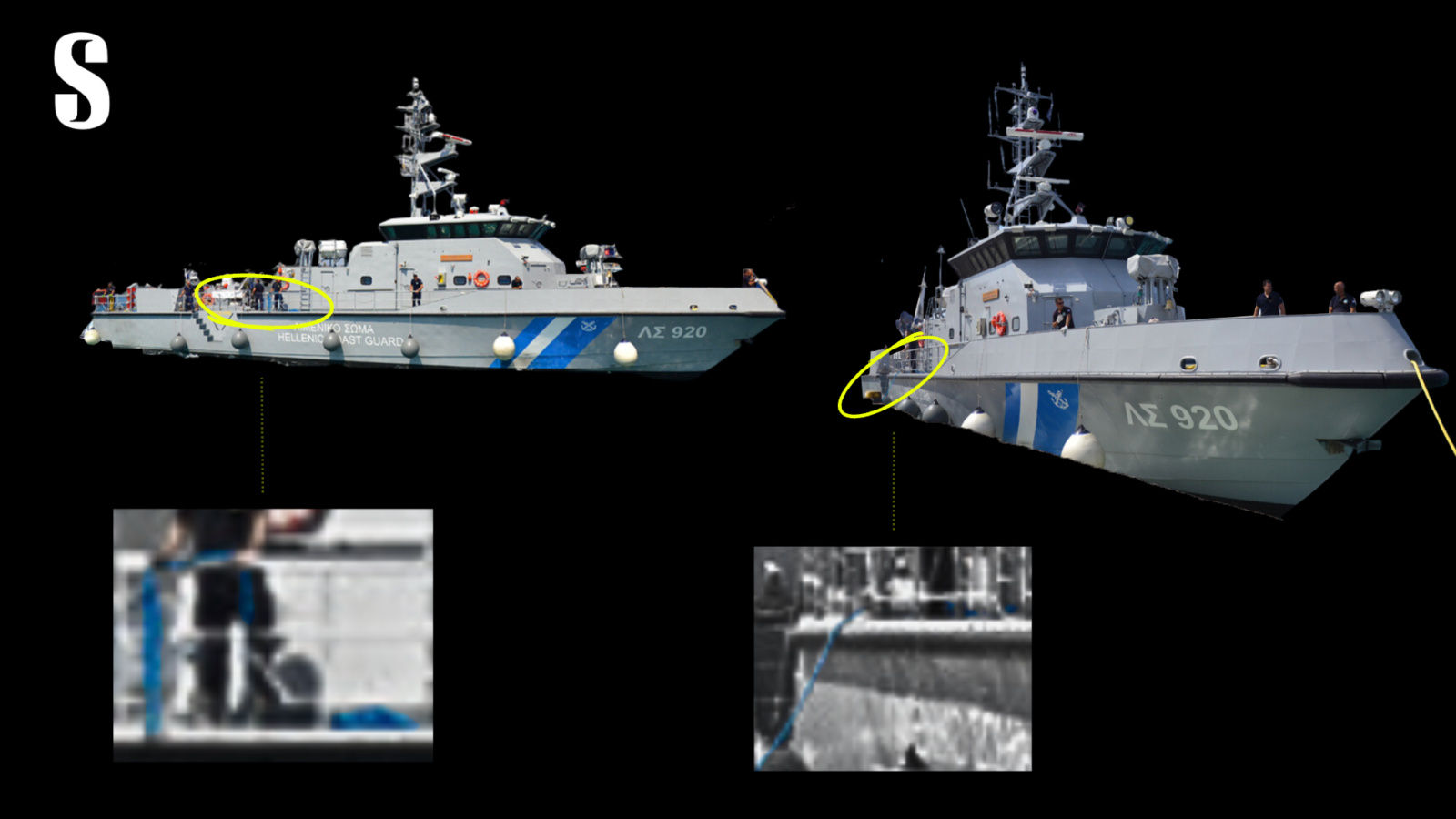
The estimation that the attempt to tow the fishing vessel by the ΠΠΛΣ-920 led to its sinking is underlined by the statements of survivors, that form part of the case file which is available to the journalists that participated in this investigation.
“Then the Greek ship came and threw the rope which was tied to the front of our ship,” says a survivor who was on the deck.
The Coast Guard started towing the fishing vessel, he adds, and “when it was going slowly the fishing vessel was fine, but instead of approaching the Greek ship we were moving away. When they hit the gas, I’m sorry to say, that’s when our ship sank.”
The same survivor estimates that the fishing boat capsized due to the “pulling from the Greek ship, because then our ship began to lean to one side. And I, who was standing in a corner, slipped into the water with a relative of mine, who died.”
Another survivor who was also on the deck, but at the stern and without full visibility, says in his testimony that “it was night, the guys in front told me that they tied the rope, but I could feel the motion too, because then we moved, but not for more than two minutes.”
“Then we said stop-stop because our ship is leaning,” he says, adding, “I think we sank due to the fact that our boat was in bad condition and overloaded and that it shouldn’t have been towed.”
In another testimony, the description of the towing attempt is concise: “On the last day the Greek ship threw us a rope and tied us to their ship. The Greek one turned right, then ours overturned and we fell into the water.”
We contacted the Coast Guard, asking questions about the timeline of the shipwreck and asking them to comment on the findings of our investigation. At the time of publication, we have not received a response.
Why didn’t Greece respond to Frontex?
The picture of what actually happened would be more complete if the ΠΠΛΣ-920 was not the only vessel present during the incident.
According to the captain of the merchant ship Faithful Warrior, at 00:18 the Coast Guard’s Search & Rescue Coordination Center gave him permission to depart the scene, thus removing the last witness present. The Faithful Warriorleft at 00:30, about 15 minutes before the fishing vessel’s engine stopped working, according to Coast Guard records.
Frontex, which operates in the central Mediterranean, had informed the Greek authorities about the fishing vessel early in the afternoon, and had offered to help.
Specifically, at 19:35 (local Greek time) Frontex offered to assist with the Eagle I aircraft. Afterwards, the Greek side asked Frontex to assist in a search and rescue incident south of Crete, where 80 people were in danger. The vessel in question was spotted by the Frontex Heron drone at 22:50.
At 00:34, Frontex again offered to provide assistance with the Eagle I and a few minutes later, at 00:52, it also offered the Heron. According to a Frontex source who spoke to our joint investigation, the Greek authorities did not respond to any request to send aerial assets to the overloaded fishing vessel.
Fabricated testimonies
Concerns have also been raised about the possible alteration of survivors’ testimonies.
Survivors gave two rounds of statements: first to the Coast Guard and then to an investigator. Both versions are available to Solomon and the international colleagues who participated in this investigation.
While there are no references to the attempted towing of the fishing vessel in the survivor testimonies recorded by the Coast Guard, the same survivors spoke about it in the second interview with the investigator.
Also, when describing the shipwreck, the testimonies that appear to have been given to the Coast Guard by two survivors of different nationalities, are the same, word for word: “There were too many people in the boat, which was old and rusty … that’s why it capsized and sank in the end.”
Inside the hold
The TikTok video shows his older brother hugging him tightly and kissing him, before he enters the airport, dragging along his suitcase.
He had flown from Karachi to Dubai, and from Dubai to Alexandria, Egypt. From there he boarded another plane that took him to Benghazi, Libya, where he spent over ten days locked in a trafficker’s hideout, before he was taken to board the Adriana.
When he saw the old fishing boat he couldn’t believe it — he thought the trip to Italy would also be by plane. He wanted to go back to Pakistan, but the traffickers wouldn’t let him.
Inside the Adriana, Abdul traveled on the lowest of three levels, in suffocating conditions where he had to sit with his knees bent. “To get from one place to another, you had to step on people.”
Conditions were similar on the middle level, where about 300 people were reportedly crammed in, with more than 200 people still on deck. The testimonies speak of another, separate space inside the fishing vessel, where women and children were located. No women were among the 104 people that were rescued.
The Pakistani travellers had paid a total of €8,000-€10,000 each for the long journey to Europe – Abdul’s family of rice farmers had sold their land to finance his trip.
Abdul had learned to swim in the canals around his family’s crops – when the Adriana sank, it was his ability to swim that allowed Abdul to reach the Coast Guard vessel and save himself.
As he walks along in Athens, Abdul’s relatives call him, asking what’s the name of the city he’s in. He tells us about his family, but he also shows us photos of loved ones who perished: he was onboard the Adriana with 14 of his friends and his uncle. Only he survived.
And of his 350 fellow Pakistanis who were also in the hold with him, only 12 were rescued. “Beautiful people were lost,” says Abdul.





